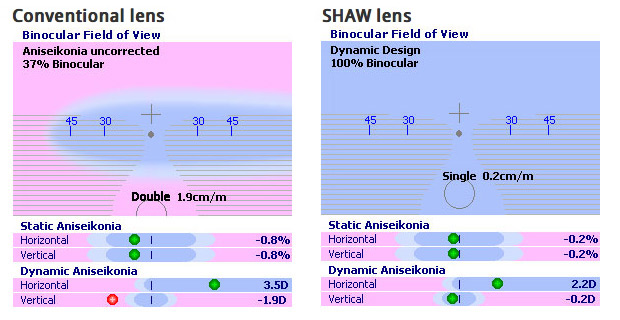
What Is the Shaw™ Lens—and Why Does It Matter?
Most of us have two eyes. And those eyes? They're designed to work together as a team. But depending on how each eye develops, they don’t always play nicely together. That’s where the SHAW™ Lens comes in.
When Two Eyes Don’t See Eye to Eye
Here’s the deal: Your eyes can develop differently—especially when it comes to prescription. One eye might be a -2.00, the other a -3.00. Or one might be farsighted while the other is nearsighted. Each eye has its own job to do, and each eye sends its own image to your brain.
But if one image is larger than the other—because of magnification from the lens—your brain has to work overtime to stitch those images together. That size difference between the two images is called aniseikonia, and it’s exhausting.
The Problem with Conventional Lenses
Let’s take a look at what’s actually happening through a lens.
Try this: Hold up a lens in front of your face and look in a mirror. You’ll see that your face might look bigger or smaller. That’s magnification in action. Now move the lens slightly side to side. Notice how your face seems to move? That’s image displacement. Your eye experiences that every time it moves—especially if the lenses in your glasses are different.
This mismatch in movement from one eye to the other is called aniseikonia with dynamic image disparity, or in simpler terms, image movement imbalance. The brain has to constantly correct for those differences, and that drains your cognitive energy.

How the Shaw™ Lens Fixes It
The SHAW™ Lens is designed to solve this exact problem.
Using advanced optical modeling, the SHAW™ system measures and predicts the image imbalance caused by your specific prescription. It doesn’t just consider each eye separately—it calculates how both eyes will work together in real life.
Then it designs the lenses accordingly. The result? A pair of glasses that:
- Reduces image size differences between the eyes
- Minimizes image movement imbalance
- Helps your brain stitch images together more easily
- Reduces visual fatigue and “battery drain”
Who Benefits from the Shaw™ Lens?
If your prescription is identical in both eyes—say -1.50 in each—then a standard lens might be just fine. But if there’s any meaningful difference between the two, your brain is constantly working to fuse two slightly different images.
That’s where the SHAW™ Lens is extremely beneficial. It’s especially helpful for people with:
- Significant differences in prescription between eyes (anisometropia)
- History of lazy eye or amblyopia
- Post-surgical vision differences
- Visual discomfort with conventional lenses
Why Isn’t This the Standard?
It’s a great question.
For a long time, glasses were just about clarity. If you couldn’t read, we gave you glasses so you could read. Binocular vision—the way both eyes work together—wasn’t part of the conversation.
Most lenses were (and still are) designed as if we’re Cyclops. Each lens is optimized for one eye. Period. The SHAW™ Lens breaks from that model and says, “Let’s design for the pair of eyes—not just one.”
That idea—designing lenses for binocular vision—is surprisingly new in practice. But it makes all the difference for comfort, depth perception, and visual performance.
The Bottom Line
You have two eyes for a reason. They’re supposed to work together. The SHAW™ Lens helps make that happen by balancing how images are seen and moved across both eyes.
It’s smart. It’s science-backed. And it can make your vision feel more natural and less exhausting.
